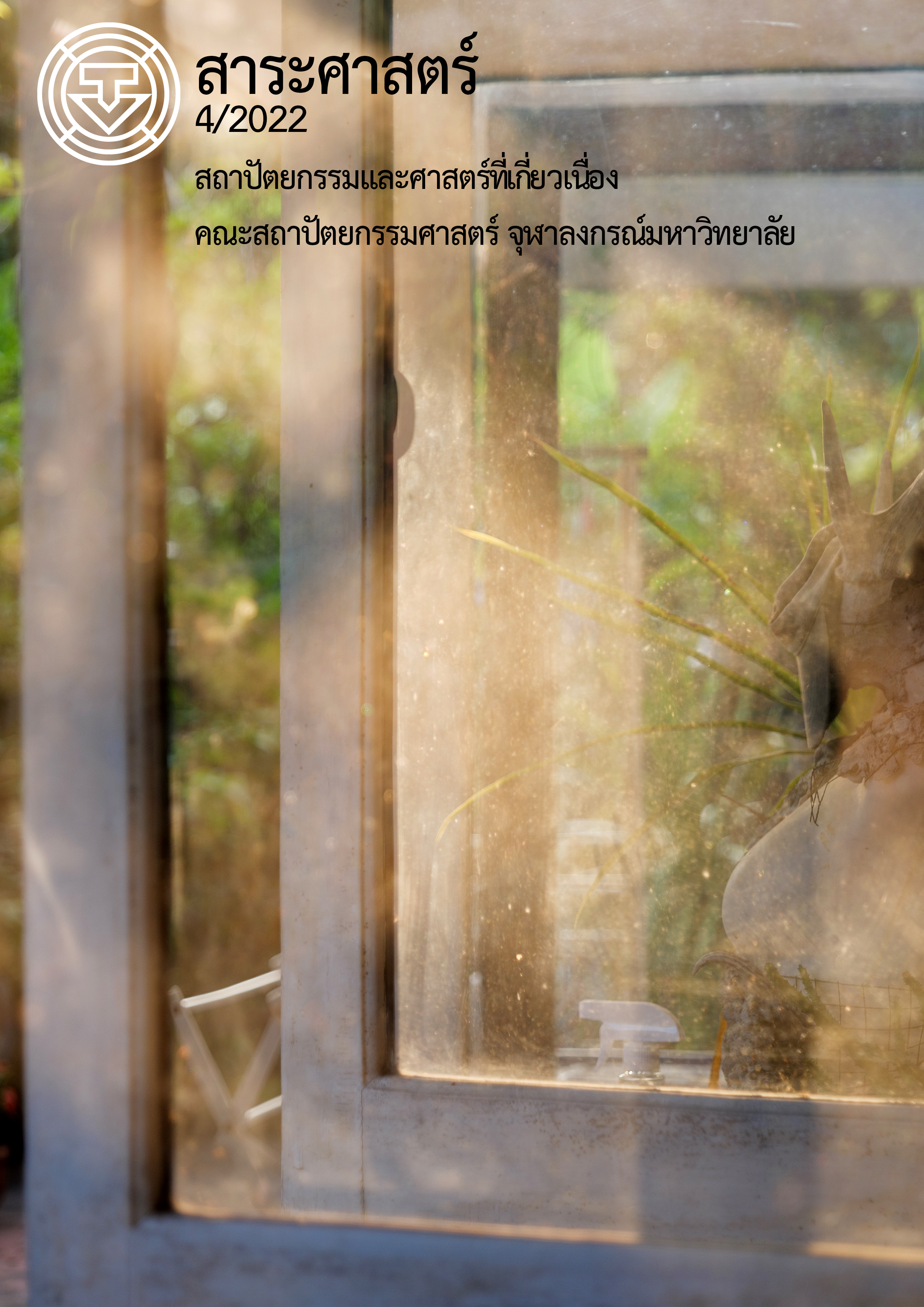การประเมินความยั่งยืนทางด้านการวางผังของย่านมหาวิทยาลัยศิลปากร วิทยาเขตพระราชวังสนามจันทร์ จังหวัดนครปฐม
Main Article Content
บทคัดย่อ
มหาวิทยาลัยศิลปากร วิทยาเขตพระราชวังสนามจันทร์ จังหวัดนครปฐม เป็นส่วนหนึ่งของพื้นที่พระราชวังสนามจันทร์ซึ่งเป็นโบราณสถานที่สำคัญของจังหวัดนครปฐม มหาวิทยาลัยฯ ได้มีการวางผังแม่บทที่มีวัตถุประสงค์เพื่อความยั่งยืนทางด้านสิ่งแวดล้อม โดยความยั่งยืนทางด้านสิ่งแวดล้อมไม่ได้หมายถึงสภาพแวดล้อมที่อยู่ภายในขอบเขตของมหาวิทยาลัยเท่านั้น แต่ยังรวมไปถึงแผนพัฒนาส่วนท้องถิ่น และการออกแบบของพื้นที่ใกล้เคียงด้วย งานวิจัยนี้มีวัตถุประสงค์เพื่อประเมินความยั่งยืนทางด้านสิ่งแวดล้อมของมหาวิทยาลัยศิลปากร วิทยาเขตพระราชวังสนามจันทร์ โดยเลือกใช้เกณฑ์ LEED-ND หมวดที่ตั้งและการเชื่อมต่อที่ชาญฉลาด (SLL) และรูปแบบและการออกแบบย่านชุมชน (NPD) มาประเมินพื้นที่ศึกษา เพื่อนำไปสู่การเสนอแนะแนวทางในการพัฒนาย่านมหาวิทยาลัยศิลปากร วิทยาเขตพระราชวังสนามจันทร์ ให้บรรลุผลความยั่งยืนทางด้านสิ่งแวดล้อมต่อไป
ผลการประเมินพบว่าพื้นที่ศึกษาในระดับย่านผ่านเกณฑ์บังคับทุกข้อในหมวด SLL และผลเกณฑ์คะแนนได้ 22 คะแนน จาก 28 คะแนน แสดงให้เห็นว่าพื้นที่มีศักยภาพทางด้านที่ตั้งและการเชื่อมต่อที่ชาญฉลาด แต่ไม่ผ่านเกณฑ์บังคับหมวด NPD ในเกณฑ์ NPD P1 (Walkable Streets) และผลการประเมินเกณฑ์คะแนนในหมวดนี้ได้ 18 คะแนน จาก 41 คะแนน แสดงให้เห็นว่าพื้นที่ศึกษามีศักยภาพต่ำทางด้านรูปแบบและการออกแบบของย่านชุมชนที่ยั่งยืนทางด้านสิ่งแวดล้อม เนื่องจากเส้นทางการเชื่อมต่อระหว่างพื้นที่ศึกษาและพื้นที่ศึกษาในระดับย่าน ขาดทางเท้าที่ต่อเนื่องที่เชื่อมต่อไปยังสิ่งอำนวยความสะดวกและการใช้งานที่หลากหลาย
ข้อเสนอแนะต่อแนวทางการพัฒนาพื้นที่ศึกษาเพื่อความยั่งยืนทางด้านสิ่งแวดล้อม ประกอบด้วย การปรับปรุงสร้างเส้นทางเดินเท้าและเส้นทางจักรยานให้มีขนาดความกว้างที่เกณฑ์กำหนดหรือการวางแผนสร้างเส้นทางดังกล่าวในอนาคต กำหนดให้อาคารก่อสร้างใหม่หรือปรับปรุงหันหน้าไปยังเครือข่ายทางสัญจรและมีระยะทางเข้าอาคารใกล้กับทางเท้า การลดพื้นที่ลานจอดรถด้านหน้าอาคารปรับเปลี่ยนให้เป็นลานอเนกประสงค์ พร้อมทั้งการจัดการบริการรอบขนส่งสาธารณะและไม่เก็บค่าบริการในพื้นที่ศึกษาเพื่อทดแทนที่จอดรถที่หายไป และการเพิ่มทางแยกการเชื่อมต่อ อาจจะลดการปิดกั้นอาคารชั้นแรกที่สามารถเชื่อมไปยังสถานที่บริการและสิ่งอำนวยความสะดวกต่าง ๆ ได้
Article Details
เอกสารอ้างอิง
กรมพัฒนาที่ดินจังหวัดนครปฐม. (2562). รายงานพื้นที่ความลาดชันจังหวัดนครปฐม. สืบค้นเมื่อ 21 มกราคม 2565, จาก http://www.nakhonpathom.go.th/content/information
สถาบันอาคารเขียวไทย. (2563). TREES-NC/CS v1.1 เกณฑ์การประเมินความยั่งยืนทางพลังงานและสิ่งแวดล้อมไทย สำหรับการก่อสร้างและปรับปรุงโครงการใหม่ และอาคารประเภทพื้นที่ส่วนกลางและกรอบอาคาร. สืบค้นเมื่อ 5 มกราคม 2563, จาก https://tgbi.or.th/trees/nc-2
สภามหาวิทยาลัยศิลปากร. (2554). ผังแม่บทมหาวิทยาลัยศิลปากร วิทยาเขตพระราชวังสนามจันทร์ พ.ศ. 2553-2573. จังหวัดนครปฐม: กองแผนงามหาวิทยาลัยศิลปากร มหาวิทยาลัยศิลปากร วิทยาเขตพระราชวังสนามจันทร์.
สำนักงานจังหวัดนครปฐม. (2565). ฐานข้อมูลนครปฐม. สืบค้นเมื่อ 21 มกราคม 2565, จาก http://www.nakhonpathom.go.th/content/information
สินีนาถ ศุกลรัตนเมธี และ รุจิโรจน์ อนามบุตร. (2561). LEED-ND และการออกแบบย่านชุมชนเพื่อความยั่งยืน. ในการประชุมวิชาการ (PROCEEDINGS):โครงการประชุมวิชาการภูมิสถาปัตยกรรม 7 สถาบัน ครั้งที่ 3 [รายงานการประชุมเชิงวิชาการ]. ภาควิชาภูมิสถาปัตยกรรม คณะสถาปัตยกรรมศาสตร์ มหาวิทยาลัยเกษตรศาสตร์, กรุงเทพฯ.
BRE Global Limited. (2017). BREEAM communities technical manual SD202-1.2 2012. Retrieved February 20, 2020, from https://bregroup.com/products/breeam/breeam-technical-standards/breeam-communities
BRE Global Limited. (2018). BREEAMUK vSD5078 new construction 2018 (Issue 2019). Retrieved May 25, 2020, from https://bregroup.com/products/breeam/breeam-technical-standards/breeam-new-construction
Universities Indonesia. (2019). Ver. ENGLISH GUIDLINE UI green metric world university rankings. Retrieved March 18, 2020, from https://greenmetric.ui.ac.id/publications/guidelines/2019/english
U.S. Green Building Council. (2016). LEED 2009 for new construction and major renovation (update July 2016), Washington, DC.Retrieved March 27, 2020, from https://www.usgbc.org/leed/rating-systems/new-buildings
U.S. Green Building Council. (2018). LEED v4 reference guide for neighborhood development. Retrieved March 27, 2020, from https://www.usgbc.org/leed/rating- systems/neighborhood-developmen
U.S. Green Building Council. (2020). A citizen’s guide to LEED for neighborhood development. Retrieved March 27, 2020, from https://www.usgbc.org/leed/rating-systems/neighborhood-development


